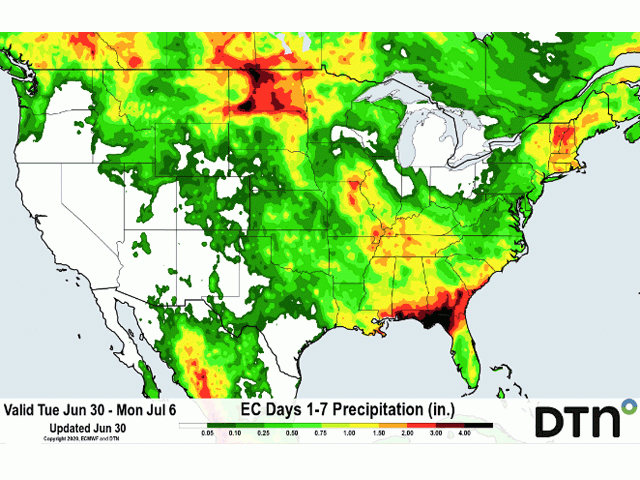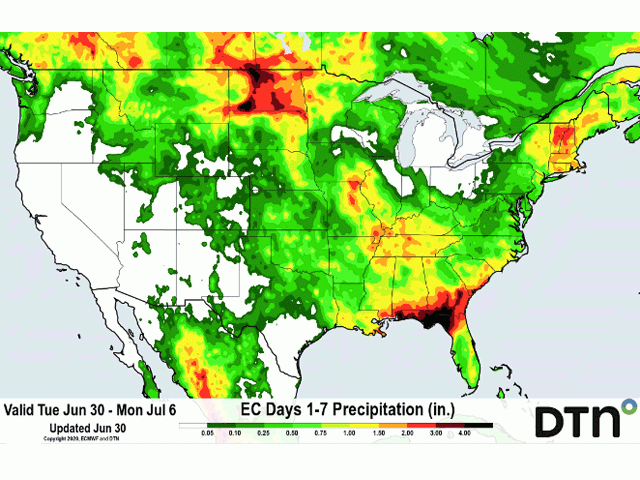Ag Weather Forum
Heat Builds With Concerning Dryness
Scattered showers fell across a majority of the major growing areas over the last week. The scattered nature did lead to some have and have-nots, however.
Many areas of the Northern and Central Plains through the Midwest saw over 0.50 inch of rainfall and there were several pockets of greater than 2 inches through over the same areas. These were very helpful in Montana, the western Dakotas, northeast Kansas, Minnesota, and the eastern Midwest. But some areas were also left out and the eastern Dakotas, western Iowa and West Texas did not see as much precipitation, hurting soil moisture and the developing crops in those areas.
P[L1] D[0x0] M[300x250] OOP[F] ADUNIT[] T[]
With widespread showers across the major growing regions, it was no surprise that crop conditions from the recent USDA crop progress report were mostly unchanged. But while showers were moderate to heavy in Kansas, harvest progressed fairly well, coming in at 47% complete. With half of the wheat still standing out in the field, weather conditions continue to be important.
The atmosphere is setting up with a stable pattern, and it is looking like a La Nina pattern, which continues to be the concern for the rest of the growing season. Ocean temperatures in the equatorial Pacific continue to hover around the threshold for a La Nina, or minus 0.5 Celsius in the ENSO 3.4 region. The atmosphere is now starting to respond to the cooling Pacific by setting up a large ridge in the middle of the U.S. This typically produces hot and dry conditions. However, portions of the country may luck out. Disturbances will move across the northern edge of the ridge, producing showers for the Northern Plains and the Western Corn Belt. While they may be scattered, they will be welcome where they do occur. Some larger thunderstorm complexes may mix in as well, bringing much higher precipitation totals where they go. Further to the south, a mid-level disturbance in the Deep South will continue periods of showers through the weekend and into next week.
The areas that are seemingly going to be largely missed by precipitation events over the next week look to be in the Southern Plains and Eastern Corn Belt. For the Southern Plains, a lingering weak front may be the focal point for some isolated afternoon showers this weekend into next week as it drifts through the region. If it can be done in the morning to mid-afternoon time period, producers will likely be able to avoid trouble for continuing the winter wheat harvest in Kansas. In West Texas, the chance for showers is even more isolated and scarce, a concern for cotton where poor to very poor conditions are already at 36%.
The Eastern Corn Belt is more concerning. With drier soils already in place, the likelihood of several dry days and above normal temperatures through next week will increase concern over available moisture as we head through early July and the onset of corn silking and soybean blooming. For at least the short term, these are the two areas to watch.
The long-range forecast is also raising concerns over heat and dryness for the rest of July and August, the prime months for moisture requirements in reproductive and early filling corn and soybeans. Long-range models are pointing at the ridge and above normal temperatures continuing through September, but do not show a bleak look to precipitation through August ... yet.
John Baranick can be reached at john.baranick@dtn.com
© (c) Copyright 2020 DTN, LLC. All rights reserved.






Comments
To comment, please Log In or Join our Community .